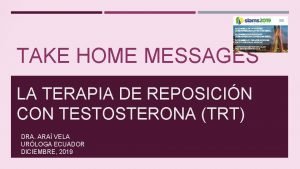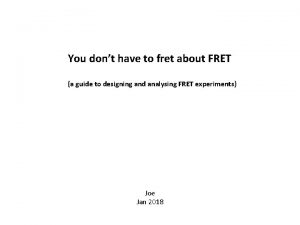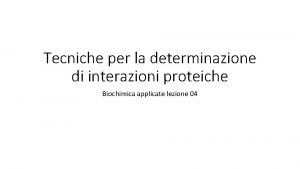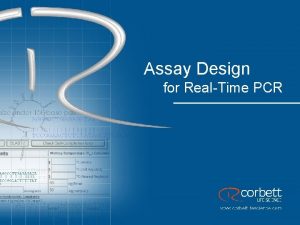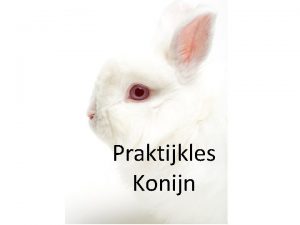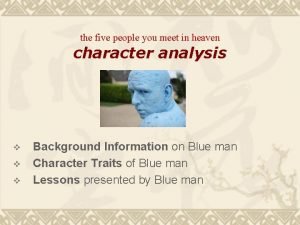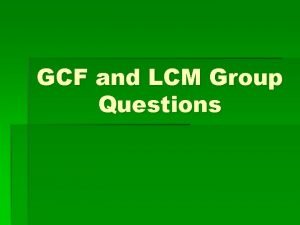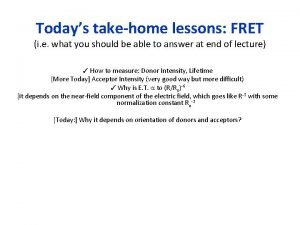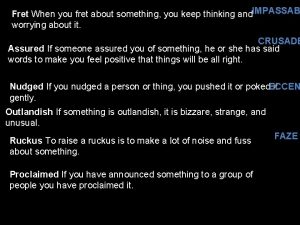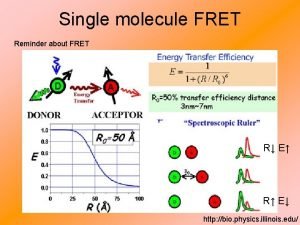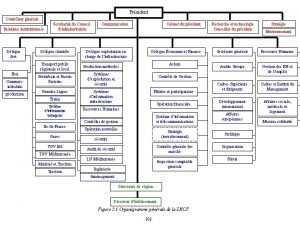Todays takehome lessons FRET i e what you








- Slides: 8

Today’s take-home lessons: FRET (i. e. what you should be able to answer at end of lecture) FRET – Fluorescence Resonance Energy Transfer (Invented in 1967) Why its useful, R-6 dependence; R 0 (2 -8 nm), very convenient. You can measure ensemble FRET and single-molecule FRET An example of DNA and a major killer, Hepatitis C.

FRET: measuring conformational changes of biomolecules FRET useful for 20 -80Å Distance dependent interactions between green and red light bulbs can be used to deduce the shape of the scissors during the function.

Fluorescence Resonance Energy Transfer (FRET) Spectroscopic Ruler for measuring nm-scale distances, binding Energy Transfer Donor Acceptor E Ro 50 Å R (Å) Time Dipole-Dipole distant-dependent energy transfer Look at relative amounts of green & red Time

Energy Transfer goes like… or Take limit… ?

Decrease in donor emission with rise in acceptor emission Energy Transfer Efficiency depends on spectral overlap of donor’s emission with acceptor’s absorption (both green arrows in previous slide) Fluorescein: Donor Rhodamine Acceptor

FRET Lifetimes w and w/o FRET Call you the Donor. You’re in a room on the top of a tall building. You’re walking around randomly with a blindfold on. There are holes of certain sizes (some big, some small) on the floor. Holes are big enough for you to fall through sending, you to the ground floor. The first hole you fall down and you emit a photon. You do this at a rate = krad (a certain number of times per second, so the rate k, has units of 1/time); the second hole you emit a bunch of phonons in the i. r. , i. e. heat, at a rate = knonrad; the third hole you fall down and pass through a room with a see-saw rate (k. FRET). When you hit it, you send a friend (called the Acceptor), who is sitting on the other end, up to the same height on another room. He the undergoes the same Your lifetime (Donor) lifetime Without FRET k = krad + kn. r. t = 1/k = trad + tn. r. QY = krad/(krad + kn. r) Your lifetime (Donor) lifetime With FRET k = krad + kn. r. + k. FRET t = 1/k = trad + tn. r + t. FRET QY = krad/(krad + kn. r + k. FRET) Notice that the lifetime decreases in the presence of FRET. Furthermore, you can alter the size of the FRET rate—make the whole bigger or smaller. The bigger it is, the larger k. FRET is, the greater the decrease in your lifetime.

Example of FRET What is the end-to-end distance on a ds. DNA? D= Fluorescein A = Tetramethylrhodamine

Class evaluation 1. What was the most interesting thing you learned in class today? 2. What are you confused about? 3. Related to today’s subject, what would you like to know more about? 4. Any helpful comments. Answer, and turn in at the end of class.
